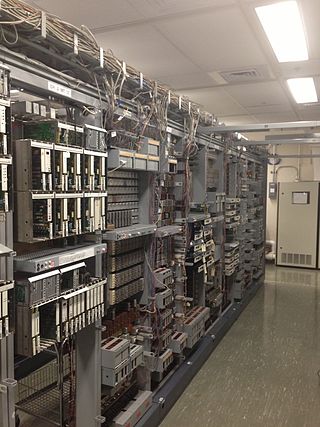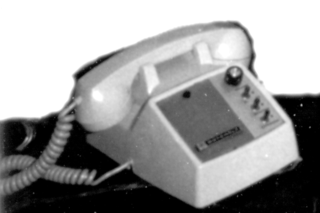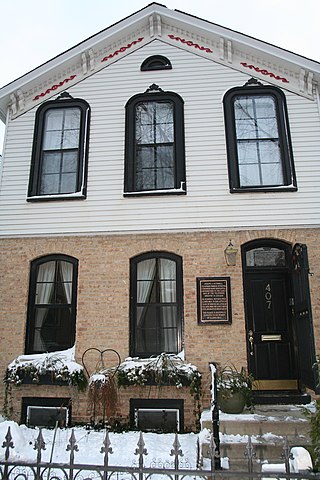Related Research Articles

A telephone switchboard was a device used to connect circuits of telephones to establish telephone calls between users or other switchboards throughout the 20th century. The switchboard was an essential component of a manual telephone exchange, and was operated by switchboard operators who used electrical cords or switches to establish the connections.
In telecommunication, a private line is typically a telephone company service that uses a dedicated, usually unswitched point-to-point circuit, but it may involve private switching arrangements, or predefined transmission physical or virtual paths. Most private lines connect only two locations, but some have multiple drop points. If the circuit is used for interconnecting switching systems, including manual switchboards, it is often called a tie line.
Telephony is the field of technology involving the development, application, and deployment of telecommunication services for the purpose of electronic transmission of voice, fax, or data, between distant parties. The history of telephony is intimately linked to the invention and development of the telephone.

In electronics and telecommunications, a crossbar switch is a collection of switches arranged in a matrix configuration. A crossbar switch has multiple input and output lines that form a crossed pattern of interconnecting lines between which a connection may be established by closing a switch located at each intersection, the elements of the matrix. Originally, a crossbar switch consisted literally of crossing metal bars that provided the input and output paths. Later implementations achieved the same switching topology in solid-state electronics. The crossbar switch is one of the principal telephone exchange architectures, together with a rotary switch, memory switch, and a crossover switch.

A blue box is an electronic device that produces tones used to generate the in-band signaling tones formerly used within the North American long-distance telephone network to send line status and called number information over voice circuits. During that period, charges associated with long-distance calling were commonplace and could be significant, depending on the time, duration and destination of the call. A blue box device allowed for circumventing these charges by enabling an illicit user, referred to as a "phreaker" to place long-distance calls, without using the network's user facilities, that would be billed to another number or dismissed entirely by the telecom company's billing system as an incomplete call. A number of similar "color boxes" were also created to control other aspects of the phone network.

A telephone call or telephone conversation, also known as a phone call or voice call, is a connection over a telephone network between the called party and the calling party. Telephone calls started in the late 19th century. As technology has improved, a majority of telephone calls are made over a cellular network through mobile phones or over the internet with Voice over IP. Telephone calls are typically used for real-time conversation between two or more parties, especially when the parties cannot meet in person.
In telecommunications, trunking is a technology for providing network access to multiple clients simultaneously by sharing a set of circuits, carriers, channels, or frequencies, instead of providing individual circuits or channels for each client. This is reminiscent to the structure of a tree with one trunk and many branches. Trunking in telecommunication originated in telegraphy, and later in telephone systems where a trunk line is a communications channel between telephone exchanges.

In the early days of telephony, companies used manual telephone switchboards, and switchboard operators connected calls by inserting a pair of phone plugs into the appropriate jacks. They were gradually phased out and replaced by automated systems, first those allowing direct dialing within a local area, then for long-distance and international direct dialing.

A business telephone system is a telephone system typically used in business environments, encompassing the range of technology from the key telephone system (KTS) to the private branch exchange (PBX).
The Traffic Service Position System (TSPS) was developed by Bell Labs in Columbus, Ohio to replace traditional cord switchboards. The first TSPS was deployed in Morristown, New Jersey in 1969 and used the Stored Program Control-1A CPU, "Piggyback" twistor memory and Insulated Gate Field Effect Transistor solid state memory devices similar to dynamic random access memory.
Direct inward dialing (DID), also called direct dial-in (DDI) in Europe and Oceania, is a telecommunication service offered by telephone companies to subscribers who operate private branch exchange (PBX) systems. The feature provides service for multiple telephone numbers over one or more analog or digital physical circuits to the PBX, and transmits the dialed telephone number to the PBX so that a PBX extension is directly accessible for an outside caller, possibly by-passing an auto-attendant.

On analog telephone lines with special services, a flash or register-recall signal is used to control functions on the public telephone exchange, PBX or VoIP ATA.
Permanent signal (PS) in American telephony terminology, or permanent loop in British usage, is a condition in which a POTS line is off-hook without connection for an extended period of time. This is indicated in modern switches by the silent termination after the off-hook tone times out and the telephone exchange computer puts the telephone line on its High & Wet list or Wetlist. In older switches, however, a Permanent Signal Holding Trunk (PSHT) would play either an off-hook tone or a 480/500 Hz high tone. Off-hook tone is a tone of increasing intensity that is intended to alert telephone users to the fact that the receiver has been left off the hook without being connected in a call. On some systems before the off-hook tone is played, an intercept message may be announced. The most common message reads as follows; "If you'd like to make a call, please hang up and try again. If you need help, hang up and then dial your operator."
The Number Five Crossbar Switching System is a telephone switch for telephone exchanges designed by Bell Labs and manufactured by Western Electric starting in 1947. It was used in the Bell System principally as a Class 5 telephone switch in the public switched telephone network (PSTN) until the early 1990s, when it was replaced with electronic switching systems. Variants were used as combined Class 4 and Class 5 systems in rural areas, and as a TWX switch.

The Number One Electronic Switching System (1ESS) was the first large-scale stored program control (SPC) telephone exchange or electronic switching system in the Bell System. It was manufactured by Western Electric and first placed into service in Succasunna, New Jersey, in May 1965. The switching fabric was composed of a reed relay matrix controlled by wire spring relays which in turn were controlled by a central processing unit (CPU).

Remote controls are used any time a two-way radio base station is located away from the desk or office where communication originates. For example, a dispatch center for taxicabs may have an office downtown but have a base station on a distant mountain top. A Tone remote, also known as an EIA Tone remote, is a signaling system used to operate a two-way radio base station by some form of remote control.
A junctor is a circuit used in analog telephone exchanges, including the Number One Crossbar Switching System, Number Five Crossbar Switching System, 1ESS switch and other switches.

Joseph John O'Connell, 1st, was an electrical engineer and inventor. He worked for the Chicago Telephone Company in the late 19th and early 20th centuries. He had many inventions including the circuit breaker and the coin return. He also created the "invisible wire" which was the first time more than one telephone conversation could occur on the same wire. Reference to some additional inventions are mentioned in Angus Hibbard's autobiography, Hello- Goodbye including an electric lamp as a signal in a burglar-alarm operated by the telephone company in 1886. He was of Irish ancestry.
Ringing is a telecommunication signal that causes a bell or other device to alert a telephone subscriber to an incoming telephone call. Historically, this entailed sending a high-voltage alternating current over the telephone line to a customer station which contained an electromagnetic bell. It is therefore also commonly referred to as power ringing, to distinguish it from another signal, audible ringing, or ringing tone, which is sent to the originating caller to indicate that the destination telephone is in fact ringing.

A telephone exchange, also known as a telephone switch or central office, is a crucial component in the public switched telephone network (PSTN) or large enterprise telecommunications systems. It facilitates the interconnection of telephone subscriber lines or digital system virtual circuits, enabling telephone calls between subscribers.
References
 This article incorporates public domain material from Federal Standard 1037C. General Services Administration. Archived from the original on 2022-01-22. (in support of MIL-STD-188).
This article incorporates public domain material from Federal Standard 1037C. General Services Administration. Archived from the original on 2022-01-22. (in support of MIL-STD-188).